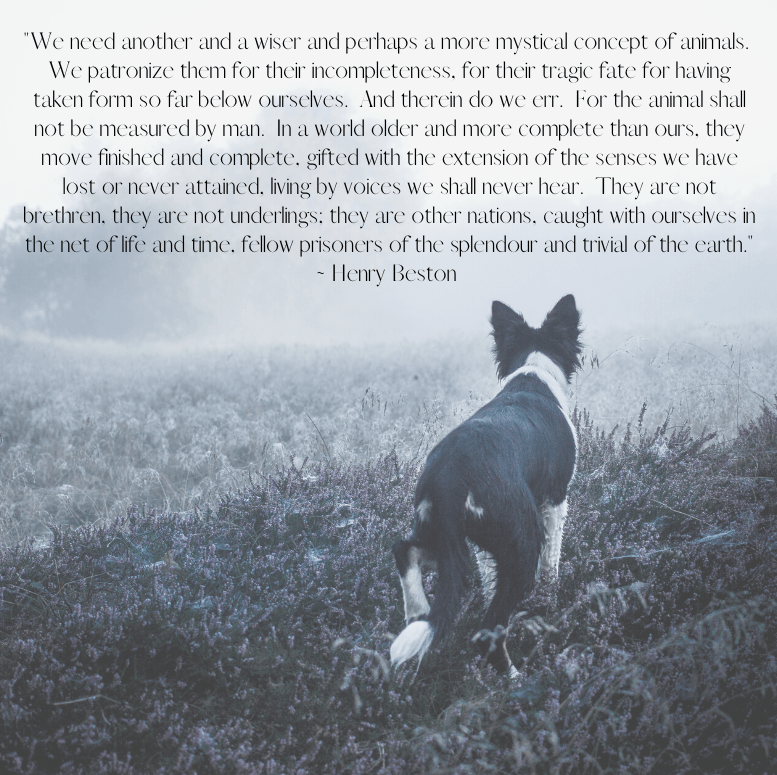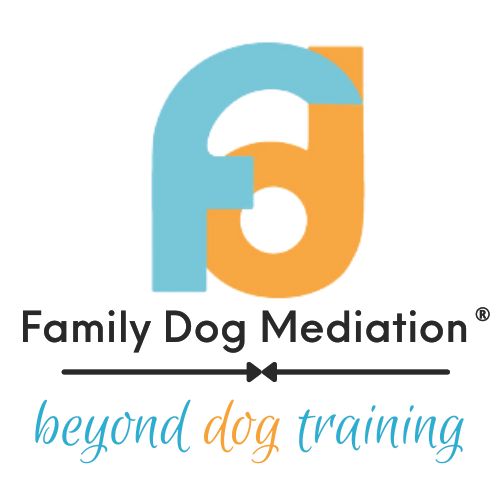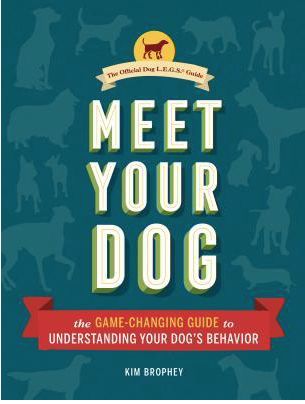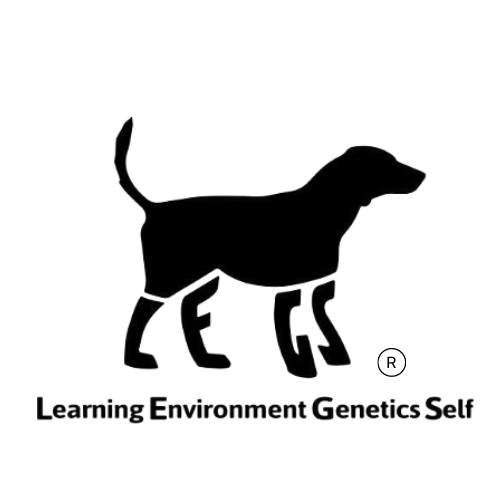History of the Pet Industry
Prior to the 1950’s, dogs were viewed from a utilitarian perspective – as a tool to make a job easier. No one had ever heard of the concept of Family Dog Mediation and the L.E.G.S. model. Beginning in the 1950’s and 60’s, the pet dog industry really started to take off. We saw the creation of dry kibble in 1956. The first national pet store franchise appeared in 1965. In 1964, a marketing campaign launched. It portrayed kibble as the only option for our dogs. How many of you remember the Kanine Krunchies jingle from the 1961 101 Dalmatians cartoon?
In the years since, the pet industry has grown at an astronomical pace. In 2017-18, we Americans spent over $72 billion dollars on our pets. This figure jumped to an unbelievable $103 billion in 2020! According to the 2021-2022 APPA National Pet Owners Survey, 69 million households in the U.S. have at least one dog. Over 90 million homes have at least one pet. When the survey was first conducted in 1988, 56% of U.S. households owned a pet. This percent has grown to 70% according to the latest survey.
History of Dog Training
Around this same time, dog training for the general public began to emerge as well. Since many of the early trainers were former WWII military dog handlers, training methods were based on that early training style. Techniques such as leash jerks, punishment and forced submission were common. In the 1960’s and 70’s, we saw the further development of dominance training. “How to be the alpha dog” by trainers like William Koehler and the Monks of Skete rose to fame. It was not until Dr. Ian Dunbar entered the scene in the 1980’s that we really start to see reward-based, positive reinforcement training methods begin to rise in popularity.
“When I’m training a dog, I develop a relationship with that dog. He’s my buddy, and I want to make training fun.”
~Dr. Ian Dunbar
In 1984, Karen Pryor’s book, Don’t Shoot the Dog, appeared on bookshelves. Karen Pryor, a marine biologist and marine mammal trainer, showed the world that these massive animals could be trained using rewards. Therefore, there is no reason that pet dogs should be trained using other methods. Still no thoughts about family dog mediation at this time.
In this video, world-renowned trainers talk about the misconceptions and myths surrounding the concept of dominance in dogs.
Current Dog Training Methods
In the past 20 years, the science around dogs and dog training has advanced in leaps and bounds. We now know those old myths about dog owners needing to be the “alpha”, “dominant” or the “pack leader” are just that … MYTHS. We know that our dogs learn best through reward-based training and that punishment often has long-term fall outs. We know that our dogs’ personalities are unique. Many different factors influence personality. For example, what the dog has learned in their lifetime, what their ancestors learned in their lifetime, what is mapped out in their DNA, how they feel, their health, etc. We shape our relationship with our dogs through our interactions in daily life, during training, etc.
Philosophy of Family Dog Mediation
The idea that what creates the dog that is sitting in front of you is based solely on Nature OR Nurture could not be farther from the truth. It is, in fact, based on Nature AND Nurture. This is, in fact, the philosophy behind family dog mediation. “It is all in how you raise them” only looks at a single chapter in the book of DOG. Puppies raised perfectly can still grow up to be fearful or reactive dogs … AND puppies that had a horrible start in life can grow into extremely well-adjusted dogs.
“Each individual is a study of one.”
~ Dr. Susan Friedman
Holistic Dog Training, Family Dog Mediation and the L.E.G.S. Framework
A holistic dog trainer looks at the big picture – how has you dog’s health, experiences, environment and genetics molded the individual sitting in front of us. One holistic framework is the L.E.G.S. model of Family Dog Mediation.
So, just what comprises each of your dog’s L.E.G.S. ?
LEARNING
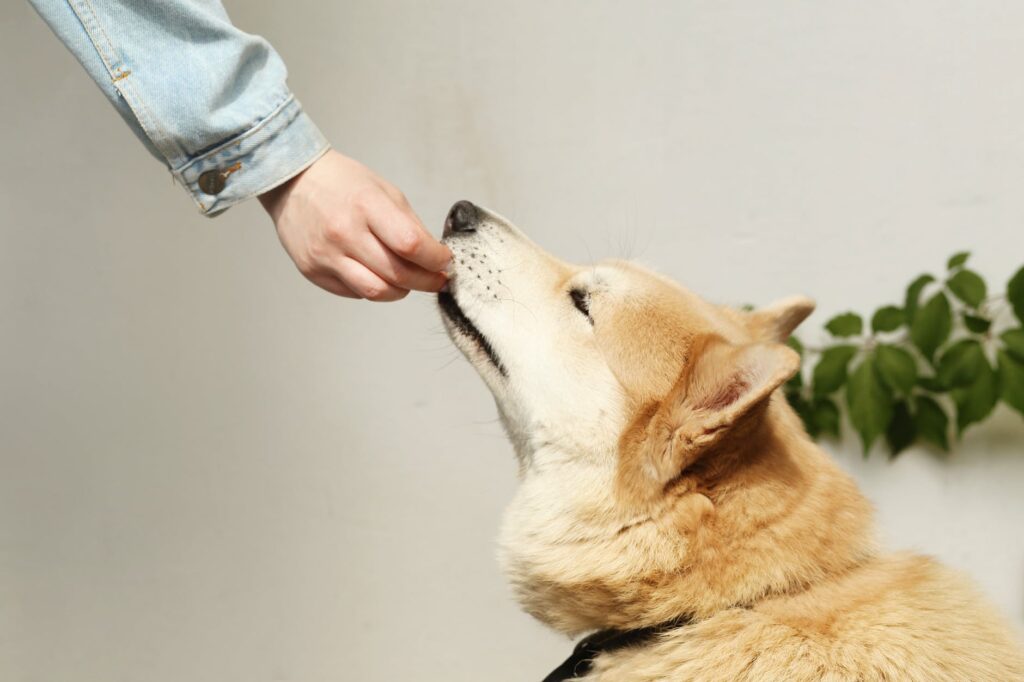
Your dog is LEARNING (L) every second of every day throughout his entire life. He is learning what is safe and what is not safe; what produces a reward and what produces a punishment; what works and what does not work. His DNA is also chock full of information based on what his ancestors learned during their lifetimes! Your dog predicts and anticipates, and then adapts to, what will happen or what will or will not work in a new situation based on what he has learned AND on what has come hard-wired from ancestral learning.
LEARNING is NEVER static
Learning is never static … rather, it is fluid. We, as owners and handlers, have the opportunity to help shape that dog sitting in front of us. A fearful puppy can become more confident through positive socialization experiences. We can help a neglected or abused dog learn to trust us.
We can teach a dog who jumps all over everyone some alternative methods of greeting, simply by rewarding preferred behaviors. Remember, a dog learns what works and what doesn’t work through trial and error. Teach your dog that keeping all four feet on the floor results in tons of yummy treats and attention. How do you think your dog’s default behavior will change in the future?
ENVIRONMENT
ENVIRONMENT (E) isn’t just the inside of your house and the yard. It is everything that your dog encounters and interacts with every single day. A dog’s environment is continually creating questions and answers – Am I safe? What is happening? What do I do? I know what this means! Our job as the human in this relationship is to control the environment to keep our dog safe and to make sure that it provides the things that our dog needs.
Is your puppy chewing on “inappropriate items?
When your puppy is teething, he is going to look for items to chew on that will help alleviate his pain and discomfort. Ideal textures just happen to be the materials used to create furniture and shoes. Wood and leather are strong, with just enough give for your puppy to really sink his sore teeth into. A teething puppy is going to chew – that is a fact. A puppy does not have the ability to differentiate between a shoe, a cell phone, a doll and a doggie chew toy – that is a fact. So, rather than getting mad at your puppy for chewing up your stuff, manage his environment. Don’t allow him to have access to these tempting items. Instead, provide him with a wealth of appropriate chew toys of different textures.

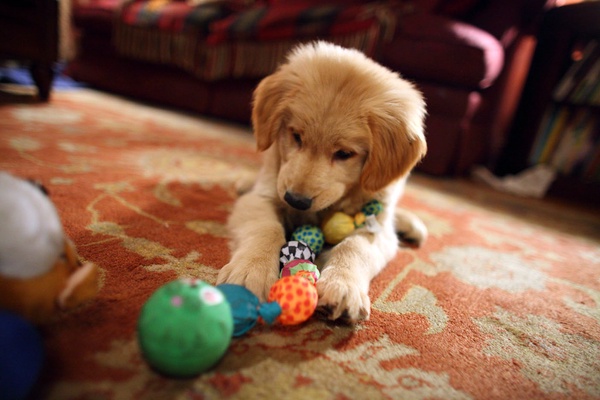
Does your dog spend the day staring out the window and barking at every squirrel, person and leaf that appears?

First, we have to acknowledge that the barking is just our dog’s way of saying, “Hey, there’s a squirrel outside!” Every dog must be allowed to use his voice. At the same time, we can work with him on only barking a couple of times and then perform a more desireable behavior such as coming to look for you. While you are teaching him that alternative behavior, we can help set him up for success by managing his environment. Close the curtains/blinds, move that couch that he is using to see out the window, or cover the window with frosted window film to prevent practicing the old behavior. We can also provide him with opportunities to bark at and chase those squirrels in other situations. Unfortunately, many training plans fail because management seems like too much work.
GENETICS
GENETICS (G) encompasses all of the information about life that is present in our dog’s DNA when she emerges from mom’s womb. These are the basics of what it is to be a dog (e.g., furry, four legs, barks, digs, chews, chases). Genetics also includes all of the specializations that humans have selected for and against since we began selecting for traits more than 10,000 years ago. E.g., the basics of herding, guarding, companionship, retrieving, etc.
Genetics are hard-wired. These are things that we can enhance or moderate through training, but we cannot diminish them completely. In fact, to do so, would remove those characteristics that make your dog a dog (or a breed of dog). Barking, chewing, and digging are all part of the essence of what makes a dog a dog. To ask a terrier to stop digging or border collie to stop wanting to control a crowd is asking him to stop being a dog. What we can do, however, is to give that terrier a designated space where he can dig. We can teach that border collie herding games that do not involve young children and then put him in the house when we have a group of kids playing in the yard.
DNA and Breed Groups
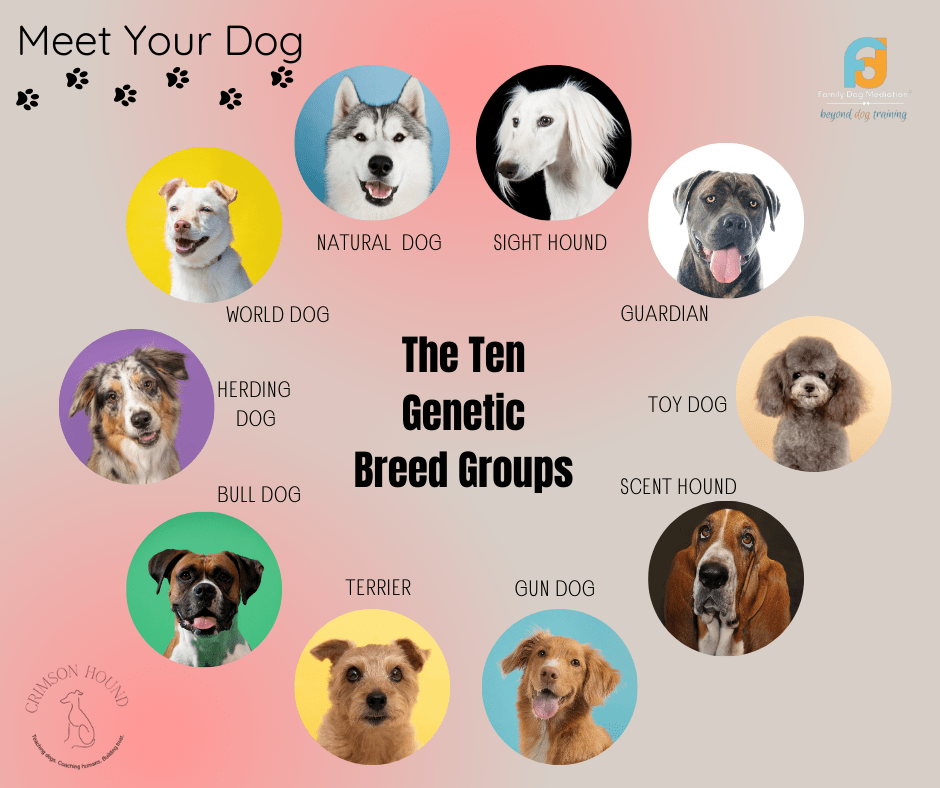
In her book, Meet Your Dog, Kim Brophey has sorted dog breeds into ten groups based on genetics. If you have a mixed breed such as a Bernadoodle where you know which two breeds make up that mix, you can generally expect to see your dog exhibiting some of the traits of each breed group.
Do you have a mixed breed dog and wondering just what a DNA test could tell you? Knowing which breeds are represented in your dog’s DNA will give you an idea of what types of behaviors you might expect to see. If you haven’t done a DNA test, you can still get a idea about his breed group. Kim Brophey has developed The Dog Key that will help you pigeonhole your dog into his genetic breed group. A family dog mediator ca help you with this. Knowing even this information can give you general ideas about traits that you might expect to see.
Keep in mind that genetics is not predictive. Just because your dog has herding traits in his DNA, it doesn’t mean that he will be a herder. DNA can predict potential behaviors – it is not a guarantee. Rather than “My dog has Border Collie DNA, so he will be a great herding dog”, think in terms of “My dog has Border Collie DNA, so that’s why he loves to herd the kids.”
Also keep in mind that many of these traits remain dormant until something turns them on. This could be the presence of a hormone, a certain stage of life, a scent or even an event. A dog can go through her entire life never having had the switch turned on.
SELF
SELF (S) considers the unique individual sitting directly in front of us. It’s her personality, her age, her sex and reproductive status, her health, her nutrition, her disabilities or injuries. Was your dog bullied at day care today? Is she feeling a bit sick to her stomach? Did she hurt herself when she caught that last ball? These circumstances are going to affect her response when the neighbor’s dog jumps in her face on the way home from the park.
Self is all about how your dog’s interior affects her exterior, her behaviors and her responses? For example, the needs of a stray, skinny momma dog with 6 puppies are drastically different than the needs of the pampered, neutered Labrador who eats the most expensive dog food and has his own leather couch. We always need to start with the dog as the individual, not a a dog in general.
Are they problem behaviors or unmet needs …
As the modern world continues to change, many of us find ourselves confused by the latest technology and even longing for days gone by. We don’t realize that these changes to our world have had drastic effects on our dogs’ lives as well. The majority of pet dogs, regardless of breed, live in an environment that is worlds away from the environment in which he was created to thrive. Those problem behaviors that we want a trainer to fix are just our dogs doing what we humans selectively, and very purposely, bred them to do for thousands of years. This is an issue with your dog’s L.E.G.S. – something you will talk more about during a family dog mediation session.
Huskies were selected to pull sleds across the arctic tundra. Today, we expect them to live happily in a condo in Florida.
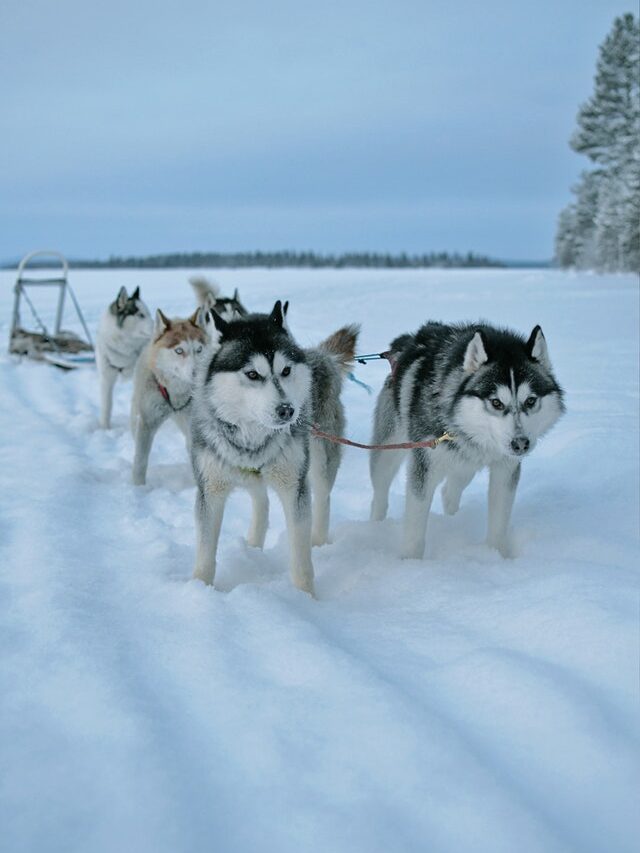

Border collies were bred to control chaos. He sees a sheep ¼ of a mile away take one step away from the flock and acts on impulse to bring him back to the flock. Today, we expect them to lie quietly while our young children run and scream through the house.
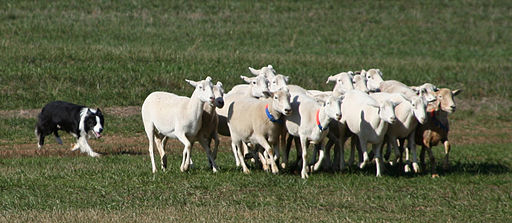
Great Pyrenees were created to live outside with the livestock. They were active at night and used their imposing presence and intimidating bark to scare away predators and thieves. Today, we expect them to lay quietly in the living room when visitors enter the home unannounced.
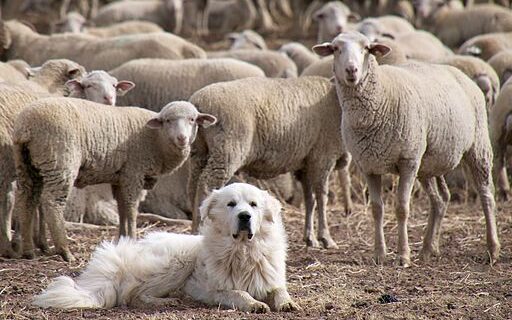
“If you think about it, it’s kind of a dirty trick to take a species that naturally chases moving objects, eats whatever it comes across, bites to argue, etc., and then announce all these as behavior problems.”
~ Jean Donaldson
… or perhaps it is just misplaced expectations?
Our pet dogs are captive animals with unmet instinctual needs and very little autonomy, as we control almost every aspect of their lives . . .when and where they eat, drink and sleep … when and where they go potty . . . who they interact with . . . how they play. You can count on one hand the aspects of our dogs’ lives that he controls.
Our dogs have been stripped of the right of refusal. Imagine, if you will, trying to dress up a wolf or a tiger – or even your cat. Get out the bandages, right?! But what happens when we decide to dress up our dogs? Now that’s a different story, our dogs had darn well better cooperate. In addition, think of this same wolf/tiger/cat/dog scenario in other circumstances – giving baths, grooming, walking on leash, recalls . . . even petting. In short, a dog is the only living being expected to perform perfectly regardless of what scenario is thrown at them. If they refuse, we seeit as a problem to be “fixed”.
Are these new scenarios realistic? Are they fair to the dog? And, in some cases, are they even humane? These are questions that you will talk about during your family dog mediation session.
Are these truly issues that need to be fixed . . . or do we just need to adjust our own expectations?
Mindset is key when working with our dogs. We need to take an honest look at our relationships with our dogs and ask ourselves . . .
– What was the original purpose of my dog?
– Am I offering my dog opportunities to meet his needs?
– Am I being realistic with my expectations?
– How can I help my dog navigate this modern world?
Rather than choosing a dog on impulse, by color or because a friend just got that breed, we must take a long, honest look at our own L.E.G.S. This will determine which breed of dog they will actually support … or if they will even support a pet dog at all. Many breeds are simply not equipped to deal with the pet homes in which we are asking them to thrive.
When we are angry, embarrassed, or frustrated with our dog’s behavior, these feelings affect our relationship. They affect our ability to constructively help our dog modify those behaviors. Shifting our mindset from “My dog is giving me a hard time” to “My dog is having a hard time . . . having big feelings . . . feeling frustrated, confused or afraid” takes our relationship to a whole new level. It creates a stronger bond and provides a foundation for creating new behaviors.
Marissa Martino of Paws and Rewards Behavior Consulting has created a wonderful FREE mini-course called Powerful Perspectives. In this course, dog owners reflect on their feelings. Then they reframe their mindset from one of anger and frustration to one of empathy and understanding.
“Dogs are doing the best they can with the education we’ve given them in the environment we’ve put them in.”
~ Susan Garrett
Family Dog Mediation can help
A Family Dog Mediator (FDM) is an individual who looks beyond “fixing” a specific issue and, instead, takes a holistic approach to assessing each dog based on their L.E.G.S. (his Learning, Environment, Genetics, and Self) because each one of a dog’s four L.E.G.S. plays a critical role in supporting that individual’s behavior.
As your family dog mediator, I will meet you and your dog where you are right now. We will work with ALL of the L.E.G.S. that both you and your dog bring to the table. My goal is to help you and your dog build a relationship based in trust and understanding. Rather than setting out to simply “fix bad behaviors” through obedience training, we will work together to create meaningful solutions.
We will talk about why your dog does what he does and how his needs may be affecting his behavior. Our conversation wil be based on honesty, compassion, understanding and compromise so that we can create a plan that will set both you and your dog up for success. I will ask for compromiseon your part in order to address your goals and meet your dog’s needs. This plan will include management protocols, enrichment activities and teaching new skills.
“Do the best you can until you know better. Then, when you know better, do better.”
~ Maya Angelou
